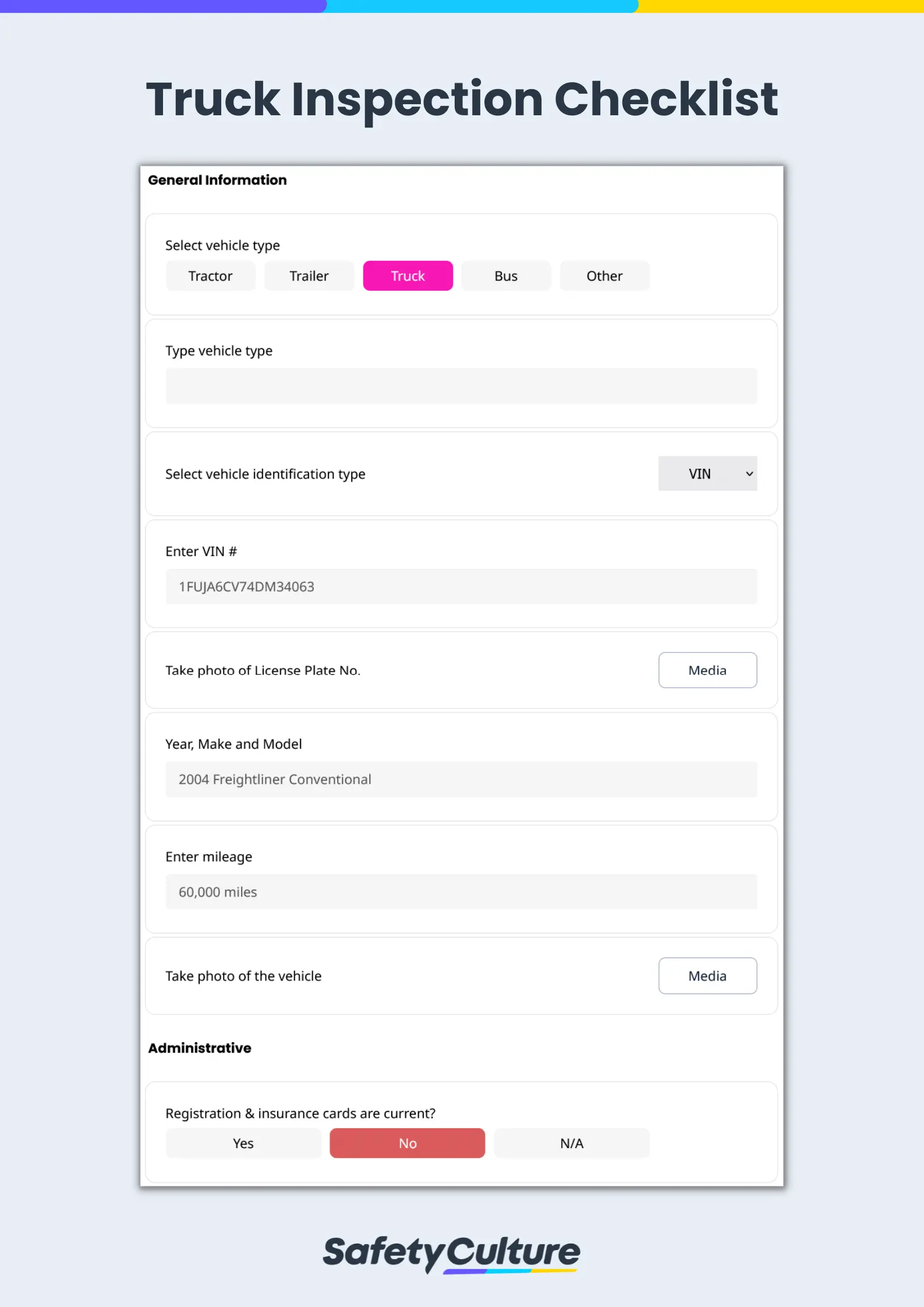What are Truck Inspection Checklists?
Truck inspection checklists or heavy vehicle inspection checklists are tools used to check trucks for roadworthiness and ensure that all parts of your truck fleet are equipped to pass annual regulatory and DOT inspections.
What is a Truck Inspection?
A truck inspection, also known as DOT inspection or DOT truck inspection, is conducted by the Department of Transportation, requiring all commercial motor vehicles (CMV) weighing more than 10,000 pounds to be evaluated in order to ensure that vehicle parts and accessories are safe and in good working condition. All CMV owners can prepare for and ace DOT inspections by performing regular checks with the use of heavy inspection checklists.
Meeting the truck inspection requirements of the U.S. Department of Transportation (DOT) and similar agencies maintains the excellent performance of these heavy vehicles. It also contributes to the prevention of road accidents and other costly problems resulting from failure to catch issues that could have been addressed during regular truck inspections.
What is Checked Using a Truck Inspection Checklist?
The following items and areas are checked using a DOT inspection checklist during routine truck inspections:
- Brake System
- Steering System
- Windshields
- Wipers
- Fuel System
- Lighting Devices
- Coupling Devices
- Exhaust System
- Safe Loading
- Suspension
- Frame
- Tires
- Wheels and Rims
- Cargo and Equipment
- Safety
- Trailer
More details on this truck inspection checklist that you can view and download for free. Also available in PDF.
How to Use the Truck Inspection Checklist
Truck inspection checklists not only help businesses prepare for the annual DOT inspection but also encourages regular heavy vehicles check-up to ensure driver, customer, and public safety. Taking advantage of a comprehensive checklist while conducting multiple inspections allows industries to streamline their process, standardize their approach, and help them avoid missing areas of inspection. Modify and use flexible heavy vehicle inspection checklists to reflect any regulatory changes from governing bodies, organizations, or industries.
Steps to Using the Truck Inspection Checklist
Follow the steps outlined to effectively use a truck inspection form:
- Specify vehicle information – Input initial data such as vehicle type, vehicle identification type, license plate, model, and mileage. Attach a photo of the vehicle as well for precise identification.
- Inspect vehicle parts individually – Completely go through the listed areas of vehicle parts to be checked. Make sure that you’re not missing anything and that the inspection is done in a detailed and factual manner.
- Indicate the status of inspected vehicle parts – Emphasize the condition of the vehicle and highlight if there are parts that need repair. Choose between OK, Needs Repair, Repaired, or N/A, or customize the options according to your business needs. This would also help in proactively addressing vehicle issues before use.
- Rate overall vehicle condition – Provide a summary by adding any other points that may affect the vehicle’s safe operation. Rate its overall condition by selecting from choices such as excellent, good, average, poor, and high risk.
- Add recommendations – Before completing the inspection with a signature, enter any recommendations that can improve the vehicle condition, if any.
Getting Ready for the DOT Truck Inspection
Most commercial motor vehicles (CMVs) weighing over 10,000 pounds have to undergo an annual DOT inspection. These inspections are carried out by qualified DOT inspectors who check all CMVs on the road are safe and in good working condition and that the business has proper recordkeeping processes in place. A DOT inspection consists of 6 levels which are:
Level 1: North American Standard (NAS) Inspection
During level 1, the inspector checks important documents such as:
- the vehicle operator’s license;
- medical certificate of their annual DOT physical exam;
- service record of the last 8 on-duty days; and
- medical card or waiver (if any).
The inspector will also check if the vehicle operator is under the influence of drugs, alcohol, or any other hazardous material. Lastly, the following elements of the vehicle will be checked: seatbelt, exhaust system, brakes, turn signals, tail lamps, headlamps, wheels and rims, windshield wipers, steering wheel, and fuel system.
Level 2: Walk-Around Driver / Vehicle Inspection
This level involves getting under the vehicle to check other parts of the vehicle that weren’t examined during the first level.
Level 3: Driver-Only Inspection
During this inspection, the inspector takes a closer examination of the vehicle operator’s credentials, such as:
- license;
- endorsements;
- Skill Performance Evaluation certificate;
- vehicle inspection reports;
- Record of Duty Status (RODS); and
- Hazardous Materials (HAZMAT) certification.
Other inspection items include seatbelt usage and signs of drug and/or alcohol use.
Level 4: Special Inspection
Level 4 is a one-time inspection that examines a specific item. It is scheduled to validate or invalidate a claim about a vehicle.
Level 5: Vehicle-Only Inspection
This level of inspection inspects vehicle parts that were specified under level 1. Its difference with level 1 is that this is conducted without the presence of the driver.
Level 6: Enhanced NAS Inspection
This level is for vehicles hauling radioactive freight. The vehicle, cargo, and driver must pass the inspection before leaving for delivery. Once all criteria are met, a special decal is given as verification of passing the inspection. The decal, however, is only valid for one trip and will be removed upon reaching the delivery point.
Other Heavy Vehicle Inspection Requirements
Requirements for inspecting heavy vehicles may vary between states and countries, but the underlying principle remains the same: ensure the roadworthiness of these vehicles. Here’s a quick overview of the truck inspection requirements in select countries:
United Kingdom (UK)
Operators of lorries, trailers, and other heavy goods vehicles (HGVs) are mandated by law to perform regular checks for roadworthiness. These inspections should be carried out in accordance with the guidelines outlined in the HGV inspection manual.
The UK’s Driver and Vehicle Standards Agency (DVSA) requires 2 types of inspections:
- Walkaround checks – This type of inspection examines the condition and safety of the entire vehicle before it’s used on the road. Drivers or other responsible persons assigned by the operators carry out this task as part of their daily responsibilities to ensure the vehicle is safe and functional when driven.
- Safety inspections – This inspection evaluates critical safety, environmental, and roadworthiness factors that can impact the vehicle’s overall performance. This procedure must be performed periodically as part of the vehicle’s maintenance activities.
European Union (EU)
Roadworthiness inspections are also needed for heavy vehicles being operated in the EU. Similar to the UK, the region’s Road Safety Policy calls for 2 mandatory heavy vehicle inspections:
- Periodic inspections – Operators are required to inspect their vehicles at specific intervals to determine if they are safe and suitable for driving. Truck inspection reports may also be submitted to authorities during unannounced roadside checks.
- Roadside checks – This inspection is carried out on the spot for any heavy vehicle traveling in the EU states. The inspector checks the overall condition of the vehicle for roadworthiness and environmental considerations (e.g., emissions).
Australia
In Australia, the Heavy Vehicle National Law (HVNL) has set the minimum requirements for safety, emissions, and anti-theft systems on a national level through the Australian Design Rules and the Heavy Vehicle National Regulation. These standards apply to all trailers and heavy vehicles weighing more than 4.5 tons.
Qualified inspectors can refer to the National Heavy Inspection Manual when inspecting trucks, trailers, and other heavy vehicles. They can also verify additional requirements (if any) from their local authorities.
Truck Inspection FAQs
The person responsible for truck inspections may depend on the type of inspection to be conducted. For example, daily heavy vehicle inspections fall under the care of drivers and safety officers. Meanwhile, roadside checks require the expertise of qualified inspectors from the governing bodies in the country, region, or locality.
Trucks, lorries, trailers, and other heavy vehicles must be inspected regularly to keep them in tip-top condition for driving. The time frame can change based on the type of inspection and regulations in your area.
For example, the DVSA in the UK recommends daily routine checks and comprehensive inspections every 4-13 weeks, depending on the age and type of vehicle. Meanwhile, the US Federal Motor Carrier Safety Administration (FMCSA) requires vehicle checks at the end of each drive and inspections on a yearly basis.
Yes, many jurisdictions have specific regulatory requirements for truck and heavy vehicle inspections. The nitty-gritty details may vary for each area, but these laws generally include specifications about periodic inspections, adherence to specific procedures, and maintenance of inspection records.



